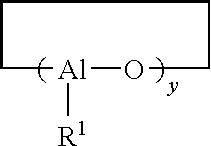Process for producing polydienes
- Summary
- Abstract
- Description
- Claims
- Application Information
AI Technical Summary
Benefits of technology
Problems solved by technology
Method used
Image
Examples
example 1
[0100]The polymerization reactor consisted of a one-gallon stainless cylinder equipped with a mechanical agitator (shaft and blades) capable of mixing high viscosity polymer cement. The top of the reactor was connected to a reflux condenser system for conveying, condensing, and recycling the 1,3-butadiene vapor developed inside the reactor throughout the duration of the polymerization. The reactor was also equipped with a cooling jacket chilled by cold water. The heat of polymerization was dissipated partly by internal cooling through the use of the reflux condenser system, and partly by external cooling through heat transfer to the cooling jacket.
[0101]The reactor was thoroughly purged with a stream of dry nitrogen, which was then replaced with 1,3-butadiene vapor by charging 100 g of dry 1,3-butadiene monomer to the reactor, heating the reactor to 65° C., and then venting the 1,3-butadiene vapor from the top of the reflux condenser system until no liquid 1,3-butadiene remained in ...
example 2
Comparative Example
[0102]The same procedure as used in Example 1 was used except that 2.50 ml of 1.0 M DIBAH in hexane was added, and tetrabromosilane (SiBr4) was used instead of CBr4. After 20.0 minutes from its commencement, the polymerization was terminated by diluting the polymerization mixture with 1360 g of hexane and dropping the batch to 3 gallons of isopropanol containing 5 g of 2,6-di-tert-butyl-4-methylphenol. The coagulated polymer was drum-dried. The yield of the polymer was 36.9 g (2.8% conversion). The resulting polymer had the following properties: ML1+4=appeared to be very low and was not measured, Mn=59,000, Mw=164,000, Mw / Mn=2.8, cis 1,4-linkage content=92.3%, trans 1,4-linkage content=5.5%, and 1,2-linkage content=2.2%.
example 3
Comparative Example
[0103]The same procedure as used in Example 1 was used except that tin (IV) bromide (SnBr4) was used instead of CBr4. After 4.3 minutes from its commencement, the polymerization formed polymer gel on the agitator of the reactor. Upon gel formation, the polymerization was immediately terminated by diluting the polymerization mixture with 1360 g of hexane and dropping the batch to 3 gallons of isopropanol containing 5 g of 2,6-di-tert-butyl-4-methylphenol. The coagulated polymer was drum-dried. The yield of the polymer was 51.4 g (3.9% conversion). The resulting polymer had the following properties: ML1+4=35.7, Mn=85,000, Mw=530,000, Mw / Mn=6.2, cis 1,4-linkage content=99.3%, trans 1,4-linkage content=0.5%, and 1,2-linkage content=0.2%.
[0104]A comparison of the results (Table 1) obtained in Example 1 with those obtained in Comparative Example 2 indicates that the use of CBr4 instead of SiBr4 yields a polymer with a high cis-1,4-linkage content and a narrow molecular ...
PUM
| Property | Measurement | Unit |
|---|---|---|
| Percent by mass | aaaaa | aaaaa |
| Substance count | aaaaa | aaaaa |
| Bit rate | aaaaa | aaaaa |
Abstract
Description
Claims
Application Information
 Login to View More
Login to View More - R&D
- Intellectual Property
- Life Sciences
- Materials
- Tech Scout
- Unparalleled Data Quality
- Higher Quality Content
- 60% Fewer Hallucinations
Browse by: Latest US Patents, China's latest patents, Technical Efficacy Thesaurus, Application Domain, Technology Topic, Popular Technical Reports.
© 2025 PatSnap. All rights reserved.Legal|Privacy policy|Modern Slavery Act Transparency Statement|Sitemap|About US| Contact US: help@patsnap.com


